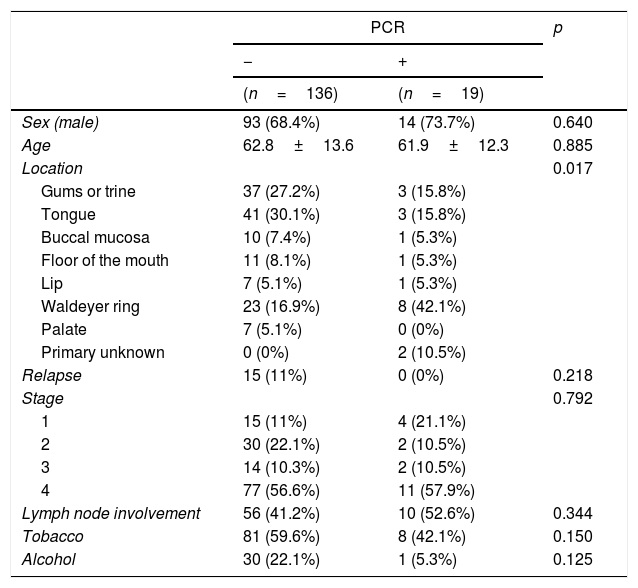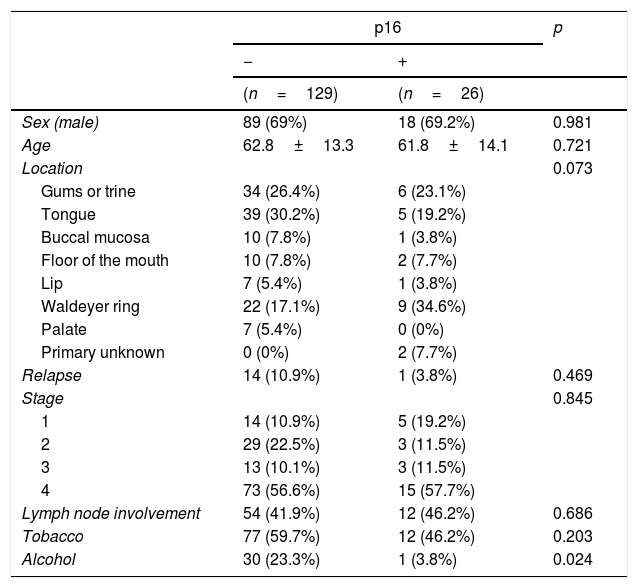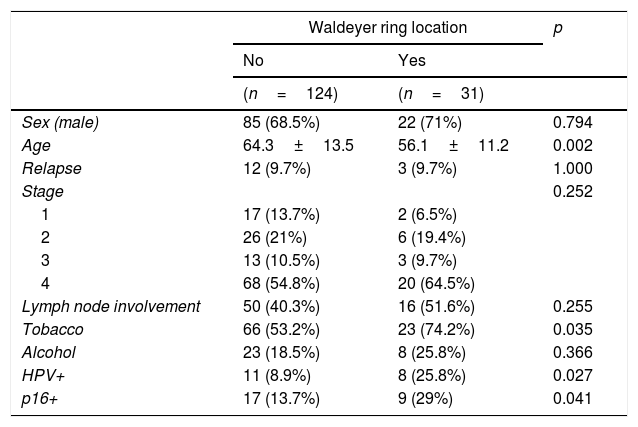Although there is scientific evidence demonstrating causation of human papilloma virus (HPV) on squamous cell carcinoma of head and neck, its percentage of causality on the anatomic region remains in dispute. This study was developed with the objectives of evaluating the relationship between HPV and oral and oropharyngeal squamous cell carcinomas (OOSCC), and of studying the correlation between HPV detection tests (PCR and p16).
Material and methodRetrospective study of patients treated for OOSCC during 2011, with a follow-up of 6 years. The sample was divided into 2 groups according to HPV positivity, detected by 2 techniques: p16 by immunohistochemistry and PCR. Demographic and clinical variables were analysed using SPSS® 22.0, considering p<0.05 to be statistically significant.
ResultsWe analysed 155 patients affected by OOSCC (mean age of 62.7, where 69% were males). Twenty six cases were p16+ (16.8%) and 19 cases PCR+ (12.3%), The HPV+ tumours were located predominantly in the oropharynx (42.1%, p=0.017) and demonstrated the tendency to be more frequent in males, with higher incidence in younger patients, lower in smokers and drinkers, and higher when patients have a greater cervical lymph node involvement at the time of diagnosis. The PCR+ patients had higher survival (p=0.024), as did the p16+ (p=0.005).
ConclusionsThe incidence of HPV in OOSCC is low (12.3%), but the clinical presentation and prognosis of the HPV+ patient differs from the classic smoker and/or drinker, which implies assessing the management of these patients independently. The p16 staining has a great diagnostic capacity to predict HPV (95.5%), although the detection of the HPV genome is still the gold standard technique.
Aunque existe evidencia científica que demuestra la relación de causalidad del virus papiloma humano (VPH) sobre el carcinoma escamoso de cabeza y cuello, su porcentaje de causalidad en las distintas regiones anatómicas permanece todavía en controversia. El presente estudio tiene como objetivos evaluar la relación del VPH con el carcinoma escamoso de cavidad oral y orofaringe (CECOO) en nuestra población de referencia, y estudiar la correlación entre diferentes pruebas de detección del VPH basadas en métodos de PCR e inmunohistoquímica.
Material y métodoEstudio retrospectivo en pacientes tratados de CECOO durante el año 2011, con un seguimiento de 6 años. La muestra se dividió en 2 grupos según la positividad a VPH, detectado mediante 2 técnicas: p16 por inmunohistoquímica y PCR. Se analizaron variables demográficas y clínicas mediante SPSS® 22.0, considerando una significación estadística con p<0,05.
ResultadosSe analizaron 155 pacientes afectos de CECOO (edad media de 62,7 años y un 69% varones). Veintiséis casos resultaron p16+ (16,8%) y 19 casos PCR+ (12,3%). Los tumores VPH+ se localizaron predominantemente en orofaringe (42,1%; p=0,017) y mostraron una tendencia a ser más frecuentes en el sexo masculino, mayor incidencia en pacientes más jóvenes, menos en fumadores y bebedores, y mayor afectación ganglionar cervical en el momento diagnóstico. Los pacientes PCR+ presentaron mayor supervivencia (p=0,024), al igual que los p16+ (p=0,005).
ConclusionesLa incidencia de VPH en CECOO en nuestro entorno actualmente es baja (12,3%), pero la presentación clínica y el pronóstico del paciente VPH+ difiere del clásico paciente fumador y/o bebedor, lo que implica valorar el manejo de estos pacientes de forma independiente. La tinción inmunohistoquímica para p16 tiene una gran capacidad diagnóstica para predecir el VPH (95,5%), aunque la herramienta de referencia sigue siendo la detección de secuencias del genoma del VPH.













